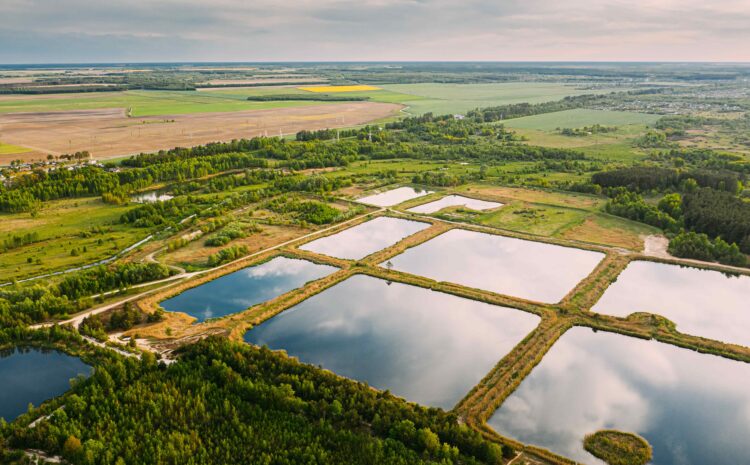
RIVER DIVERSION | CREEK BYPASS
To allow work on one part of a river or creek, temporary diversion methods like river diversion or creek bypass can be employed to divert water flow to the specified segment of the water body. One such project is the integrity dig, installation of pipelines, or protection of banks. Construction of detention ponds, dams, in-stream grade control structures, utility installation, and maintenance work all necessitate operating in rivers, thus diversions might be implemented during such times.
Temporary diversion channels, pump-arounds, piped or hose diversions, coffer dams, aqua-dams, and other such activities are all ways for river diversion or creek bypass. Temporary diversions exist for the express goal of creating a safer environment for construction work, preserving water quality, and protecting aquatic life by redirecting river or stream flows around an active construction zone.
Whitewater’s Designers and engineers examine a range of options when devising a temporary detour, including:
– Should a project use a temporary detour, and would it do more damage to the environment if erected without one? ( Alternatives to the usual procedures may be considered for short-term projects, such as bank erosion repair or pond upkeep)
– Accurate project-duration and construction-time estimations.
– The expected water flows and other measurements of the river, stream, or creek.
– Larger streams with vast tributary regions with greater flow rates or season variations in inflow water from rain and snow melt should get special consideration.
– The river and its water quality, aquatic life, and extra water filters, such as sediment management, all benefit from preservation.
– To ensure permits, traffic management, and other requirements are all in place, the area around the project and the property owners are examined. (for instance, in a densely populated metropolitan region where land is scarce, construction of a diversion system may be difficult)
– Annual changes in the flow of a stream (baseflow vs. peak flow).
– WMS designers work with clients to account for various scenarios and to integrate redundancies and backup pumping as they calculate the possibility of rain events or up-stream activities affecting diversion failure.
The WMS procedure begins with a detailed analysis of the project site, topography, and water requirements.
We follow this up with an in-depth “Diversion Plan” or “Bypass Pumping Plan” that includes a job-specific summary, including every project detail.
These plans take into account the flow of rivers and creeks, groundwater conditions, and the water table, as well as whether or not additional filtering and disposal locations are needed.
The Pumping plan contains both primary and standby pumping unit needs, as well as comprehensive AutoCAD drawings of the pumping equipment locations, shown in a diagrammatic form.
WMS collaborates with clients and other government authorities to make sure the project’s fish movements go smoothly.
Our customised pumping systems will have Department of Fisheries and Oceans-approved suction components, and will be equipped with versatile and adaptive systems that will be able to adapt to whatever we may find in our travels.
RIVER DIVERSION AND RIVER BYPASS
The process of transferring water appears easy at first look, but it is actually the preparation, planning, and execution prior to pumping hydrotest water that makes it a challenge. The strict standards Canada has for pipeline construction and integrity are among the most demanding in the world, and our work supports the project’s success with owners and builders.
However, prior to Whitewater’s technical designers and engineering crews showing in, project management groups from our clients’ teams and Whitewater’s coordinators focus on essential activities:
– Test water analysis is performed to verify appropriateness and to create a baseline so that returning test water is cleaner than the original source.
– The installation of water meters, guaranteeing that the quantity of water ordered on the TDL is taken and returned.
– In order to make sure all stakeholders were contacted and agreed to a temporary water supply pipeline crossing their land and existing utilities, cross-access agreements are put in place.
– When the hydrotesting of all pipelines is finished, water filtration systems will be in place and will guarantee that water obtained from the source is cleaner than when it was first extracted. To avoid temperature shock to aquatic life or vegetation, test water is heated during testing, but is then cooled to the temperature of the source water before it is released.
– Suction inlets with fish screens will be installed to prevent any aquatic life from being harmed.
– Procedures to ensure safe entrance are implemented with the requirement of life boats and life jackets.
And more.
While steel is used for most pipelines in Canada, certain pipelines for natural gas employ HDPE and aluminum. Pipe is welded to construct steel pipelines. Steel pipe seams are X-rayed after welding them together to ensure the welds are solid. The pipe is then coated or wrapped with protective or cement coatings and finally buried.
Pipeline inspection occurs for all types of pipes. Whitewater reinforces the Hydrostatic pressure test, which is crucial. The hydrostatic test is a method of evaluating the strength of pipelines by subjecting them to a pressure greater than their working pressure. This is a requirement before pipelines are placed into operation. The Hydrotesting support service may involve the use of specific industrial water heaters or water filtration for cold weather testing, or the transfer of test water for pressure testing.
Whitewater is happy to help Canada’s energy sector and municipal infrastructure development flourish and expand. But keeping Canadians employed is equally as essential as running a Canadian-owned and operated business, and that’s why everyone at WMS is so pleased to be a part of it. This wonderful team of committed project managers, technologists, designers, and administrators has managed to stick together and develop as leaders, mentors, and supporters of each other over the past couple of years! It is easy to see how they continuously add to the strong reputation of Whitewater Management Services, a brand synonymous with excellence.